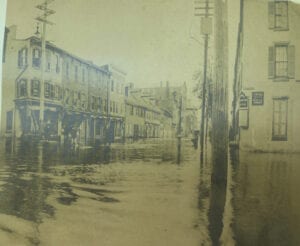In October of 1903, the majority of the East Coast was submerged underwater after one of the most destructive tropical storms touched ground. For five straight days, towns adjacent to the Delaware River valley became an aquatic dystopia.

“Up and down the East Coast, it was the same story: rain and plenty of it,” said Jon Blackwell in a historical archive of The Trentonian. “The floods of 1903 left Trentonians stunned and awed by the extent of their sufferings.”
The devastating series of flooding began on a Wednesday, October 7, when a tropical storm dispersed along the Virginia Capes. The hard-hitting tempest created heavy rain that down-poured across the entirety of the East Coast.
As the rain kept falling, residents of Trenton, along with locals of nearby towns such as Lambertville and Easton PA, watched helplessly as water levels continuously rose. According to The Trentonian, some cities witnessed water levels at up to 28 feet.
“When the stage hits 21 feet, the water will start flowing over its banks and into the basements of houses along the river,” states the U.S. Geological Survey. At 7 feet over the flood beginning stages, neighborhoods and communities faced severe damages.
“In South Trenton and along the Assunpink Creek in the North, lawns became small ponds and low-lying roads turned into Venice-style canals,” stated The Trentonian. According to reports, nine different bridges connecting PA to NJ were completely uprooted and “smashed to splinters.”
There was no way of preventing the flooding. Rain water that had poured off of the northeast PA hillside gathered in streams that constantly supplied the Delaware River with an abundance of water. The cities could only sit by and watch as the horrific event played out.
During this time, the first ever world series baseball game was rained out twice before the Boston Pilgrims defeated the Pittsburgh Pirates. Over in Kitty Hawk, NC, the historic aviators, the Wright Brothers, documented their own experience with the tragedy.
“We spent whole days indoors, on account of rain and water above camp,” wrote Orville Wright in his diary entry of October 11 of that year. The absurd weather kept the airmen from assembling their untested aircraft.
At least three men died from drowning in the floods pathway around the Delaware Valley. After 10 days of downpour, laborers attempted to mend the drowned bridges at Washington Crossing. During their efforts, two trains collided, killing 17 workers.
By Saturday, October 10, the downpour had stopped and locals believed it was finally the end. The Times wrote, “It is likely that the worst has passed.” However, later that same evening, the rain resumed.
The build up of water from the Lehigh River merged with the Delaware Valley sweeping everything in its path with it. According to The Trentonian, farmhouses were destroyed, cattle were drowning and piles of driftwood were floating along the stream-like streets.
In another turn of events, the Yardley-Trenton bridge collapsed and “with a roar that could be heard a mile away, the debris came crashing into the Calhoun Street bridge.”
In the south of Trenton, over 100 traumatized and overwhelmed individuals had to be evacuated using a boat, which floated to second story home windows. Damages, according to The Trentonian, cost around $7 million.
Days after the record flooding, affected areas rushed to repair damaged properties and bridges. At 5:45 a.m. on Saturday, October 17, 50 laborers boarded a train leaving the Warren Street Station. Workers were headed north on the Belvidere Railway, toward the damaged Washington Crossing bridge.
“The laborers were packed shoulder-to-shoulder in an old passenger coach; behind them was a tool car and a flat-bottomed, iron car,” stated Blackwell of The Trentonian. “This was dangerous procedure, as the crew knew that another work train, No. 1229, was creeping up just six minutes behind.”
With one tragedy following another, the dangerous procedure took a turn for the worse when workers missed the train approaching signals. By the time engineer Robert Reed saw the signals, he realized it was too late.
“When I realized the situation I pulled the whistle cord, called to my fireman and yelled with all my might to the men ahead,” Reed told The Trentonian. “Then I jumped.”
“With the deafening clang of steel against steel, Reed’s train bumped into the flat-bottomed car. That car telescoped the tool car, which in turn hurtled itself forward into the wooden passenger car,” stated Blackwell.
Train firemen and others at the scene attempted to help rescue the now crushed laborers. It took over an hour for trains of police to come and assist. That train accident alone left 17 dead and 33 injured and many permanently crippled.
The flood of 1903 deviated the city of Trenton and thousands of others up and down the East Coast.
“It was the spectacular event of recent years, possibly the greatest natural phenomenon which many…had ever seen,” local writer Francis B. Lee wrote after the flood. “A fortnight will see much of the damage discounted. As for the flood of 1903, it will become a matter of history.”





